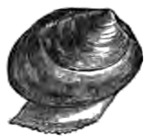has two siphonal tubes, which are long, and may be curved. The margin of the mantle also is crenate.
The animal of Leda pygmæa, which Möller mistook for a true Nucula, and described under the name of Nucula lenticula, is intermediate in character between his Leda and Yoldia, as will be seen from the accompanying figure, drawn from a living Scottish specimen.
In both forms we see exsertile siphons, which are wanting in the true Nuculæ; as in Nucula tenuis.
This important distinction shows that the division of the lamellibranchiated Acephala into two groups, according to the presence or absence of prolonged siphons (corresponding to the integrity or sinuation of the pallial impression in the shell), is artificial. In the Nuculidæ it is evident that the dental characters of the hinge are of more importance. The genus Solenella, which M. A. D'Orbigny has separated from the Nuculidæ, By on account of its sinuated pallial impressions, and placed among the Anatinæ, may therefore be restored to its former and natural position.
69. Leda minuta (Arca sp.), Otho Fabricius.
Syn., Nucula rostrata, Sowerby. Nucula tenuisulcata, Couthouy (fide Gould).
Loc., fossil. In most of the British glacial beds, but not so common as the next (Russia?).
Loc., living. British, Scandinavian, and Arctic Seas. Greenland and Boreal America.



